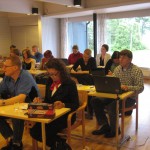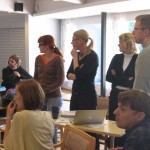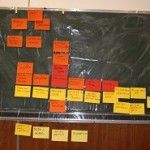We carried out the fifth HEXAnord meeting in Åland September 21-23, 2011. We were 22 participants from Scandinavia, USA and UK. The theme of this meeting was “Pragmatics of using, representing and accessing clinical text and information” and was organized by Øystein Nytrø, from NTNU, Trondheim, Norway but the lectures were the senior particiapants. The theme was also part of the PhD-training course with 12 PhD students from the network. Special invited guests were Rebecka Janols from Uppsala University and Mike Conway from University of California, San Diego. Mikes trip to Scandinavia were carried out within the framework of the Interlock project. Except of working we also did both sauna and sea bathing, a bicycle excursion and danced on the beautiful island of Åland.
EnRiMa Workshop in Vienna
The 7-8th September, Janis, Nam and I visited Vienna to have a workshop within the EnRiMa project. The purpose of the workshop was to continue to refine the requirement for the decisions support system aimed at helping building managers of public buildings to make better use of new technologies to lower costs and CO2 emissions. Following the “nordic tradition” of agile enterpri
se modeling we did participative goal and process modeling on plastic sheets. Participating in the modeling sessions was also project partners from IIASA and CET.
For further information on the project visit http://enrima-project.eu
https://dash.dsv.su.se/2011/09/14/2614/
Upcoming seminar:
Thursday 15th of September at 12.00 o’clock, Johan Blomkvist, Ph D
candidate at Linköping University presents his licentiate work entitled
“Conceptualising prototypes in service design”.
The seminars are held at K2lab, on the 7th floor, elevator C, in the open
space for HCI seminars.
Welcome!
Forthcoming Book on E-Health Communities
“E-Health Communities and Online Self-Help Groups: Applications and Usage” is the name of the book expected to be launched by IGI Global in October 2011. It is edited by me, and it is concerned with self-help groups and health issues of many different kinds, presented by authors from around the world. It covers self-help groups that struggle with health disorders, disabilities, lifestyle issues, and other health concerns. The book has recently entered the final stage of the production process.
More information can be found on the publisher’s web page where the book is announced.
Paper accepted at iStar 2011
Modeling Strategy Maps and Balanced Scorecards using iStar
Giannoulis C. & Zdravkovic J.
Aligning business strategy to enterprise models requires explicit models from both areas, mapped to each other. Mapping existingbusiness strategy definition approaches to requirement engineering practices improves strategy dissemination towards development. In this paperwe present an illustration of such a mapping using the Strategy Mapsand Balanced Scorecards as a business strategy approach and iStar (i*)as a requirements engineering practice exemplified using a case scenario. (Full paper here)
Paper nominated for the “Best Paper” award at the Americas Conference of Information Systems (AMCIS 2011) Detroit, Michigan, USA, 4-7 August, 2011
The paper named “Critical Success Factors Framework for Implementing Effective IT Governance in Public Sector Organizations in a Developing Country”, written by Edephonce Nfuka and Lazar Rusu was nominated among other 10 papers for the “best paper” award at the Americas Conference of Information Systems (AMCIS 2011) held in Detroit, Michigan, USA. The paper was nominated out of 400 papers accepted for presentation and publication in the conference proceedings. The Americas Conference of Information Systems is among the 31 conferences in Information Systems area that is ranked “A” out of 244 (68-B and 145-C) according to Australian Research Council: http://lamp.infosys.deakin.edu.au/era/?page=cfordet10&selfor=0806
For more information about our paper published in the AIS Electronic Library please access the following link: http://aisel.aisnet.org/amcis2011_submissions/365/
Paper accepted at PoEM 2011
Bringing Enterprise Modeling Closer to Model-Driven Development
Iyad Zikra, Janis Stirna, Jelena Zdravkovic
Enterprise Modeling (EM) provides the means for using models to represent organizational knowledge from different perspectives. When information systems (IS) are involved, Model-Driven Development (MDD) is an approach that focuses on the use of models as primary development artifacts. By observing that EM provides the context for high level requirements, which in turn are the input to MDD, we propose a meta-model that integrates enterprise models and requirements with design models in MDD. The meta-model defines six models that cover both organizational and IS development knowledge. Inter-model relationships ensure an integrated view of the enterprise and the supporting IS by allowing model components to be used across different models. The integrated meta-model is demonstrated through an example case study.
3 papers presented: RCIS2011, BIS2011, BUSITAL2011
- RCIS 2011
Modeling Business Strategy: A meta-model of Strategy Maps and Balanced Scorecards
Giannoulis C., Petit M., Zdravkovic J.
Business strategy is aimed to support the vision of anenterprise, by paving the way to achieve it through goals thatdirect the strategy’s execution. However, there is a lack of means to establish and assess the alignment of business strategy andgoal oriented requirements engineering. The objective of our ongoing research is to model business strategy in order to establish well-defined and traceable links with system requirements. In this paper, we propose a business strategy metamodelfor Strategy maps and Balanced Scorecards. The validity of the meta-model is tested through a case scenario using OWLand Telos.
- BIS2011
Towards a Goal-Driven Approach for Business Process Improvement Using Process-Oriented Data Warehouse
Shahzad K. & Giannoulis C.
An emerging approach for business process analysis is to usebusiness intelligence practices by employing data warehouse and decision making techniques. However, little work has been done on developing coremethods and tools to guide process analysis and improvement. Our researchaddresses this issue by introducing a goal-driven approach for business processimprovement using process warehouse. In this paper, we present our three stepmethod and its evaluation through an empirical study. The results showed thatthe impact of applying our method for process improvement has been perceived positively. (Full paper here)
- BUSITAL 2011
Modeling Competition-Driven Business Strategyfor Business IT Alignment
Giannoulis C., Petit M., Zdravkovic J.
Business strategy aims at supporting the vision of an enterprise,by paving the way to achieve it through goals that direct thestrategy’s execution. Aligning business strategy to system requirements requires explicit models from both business strategy and requirementsengineering. However, existing business strategy definition approachesare informal and their syntax is based on natural language, therefore,they cannot be used in model-driven alignment. An objective of ourresearch is to define a well-structured business strategy modeling language.In this paper, we propose a business strategy meta-model basedon Porter’s work on competition driven strategy and its extension byStabell and Fjeldstad. Our UML meta-model is formalized in Telos and OWL. An initial validation is performed by instantiating the meta-modelusing a case scenario. (Full paper here)










